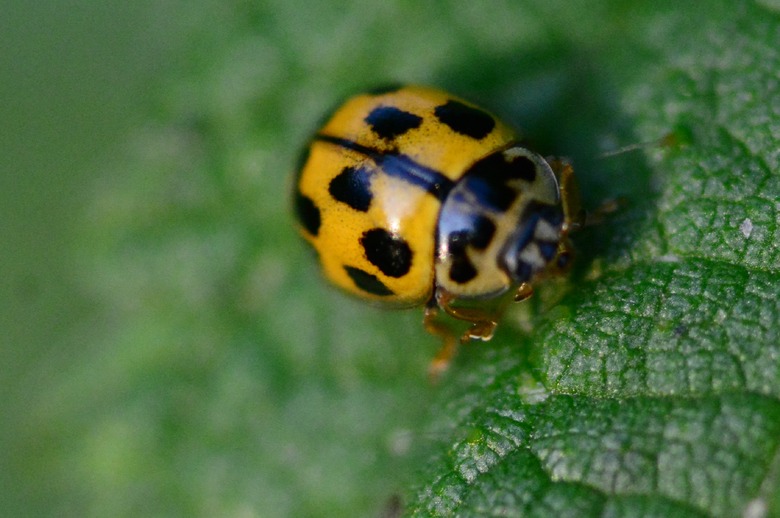How To Get Rid Of Asian Beetles In The House
There's a wise old tale that states you should never kill a ladybug because they'll bring you good luck, but if you've ever come across an Asian lady beetle, you know they can be the bane of your existence. As with other ladybug beetle species, the Asian lady beetle is cute, but that doesn't mean you'll want them hibernating in your house throughout the winter. They may be a pest if they take up residence in your home, but there are ways to get rid of them.
Asian Lady Beetles
Asian Lady Beetles
Adult Asian lady beetles are known to be oval-shaped and measure about a quarter-inch long. You can find these beetles in a variety of colors, such as tan, orange and red, and they have many black spots on the wing covers. Although the black spots are a common indicator of these beetles, some have limited spots or none at all. Although most Asian Lady beetles do not bite, they emit a foul-smelling, yellow liquid from their leg joints when they feel threatened.
You can tell the difference between male and female beetles because male beetles have few to no spots and females are generally multi-spotted. Asian lady beetles lay eggs that are yellow, oval and in clusters. These clusters can be found on the underside of leaves, and they hatch into larvae that are orange and black.
In their native Asian lands, you can see the beetles living in trees, mainly cohabitating in forests or orchards. In Japan, you can find them in soybean fields. In the United States, though, you can find the beetles living in ornamental and agricultural crops, such as roses, corn, soybeans, alfalfa and tobacco.
Where are Asian Lady Beetles From?
Where are Asian Lady Beetles From?
Asian lady beetles, scientifically known as Harmonia axyridis, were first reported in the early 1900s. Asian beetles are native to Asia, hence their name, and can be found in China, Russia, Korea and Japan. Asian lady beetles are known to dwell in trees and fields, and they prey on aphids (a minute bug that feeds by sucking sap from plants and causes massive damage to crops) and scale insects.
From the 1960s to 1990s, the U.S. Department of Agriculture used Asian lady beetles to control damaging crop pests. Large amounts of these beetles were released in Georgia, South Carolina, Louisiana, Mississippi, California, Washington, Pennsylvania, Connecticut and Maryland to control the damage to crops, especially to pecan and apple trees.
Asian Lady Beetle Infestation
Asian Lady Beetle Infestation
If Asian lady beetles have found a place in your home, it's difficult to get them out. Although there are several ways to get rid of them, even if they're inside your house, the easiest way is by using a vacuum cleaner.
The beetles like to congregate in large numbers throughout the late fall and disperse over winter. They'll cluster on the sides of homes or buildings and will find their way in through small cracks, crevices, natural breaks in window panes, door jambs or through the foundations of houses and buildings. They like to find places to spend the winter and will hibernate until the first warm days of late winter/early spring.
Asian lady beetles are attracted to lighter colored houses and buildings. The reason they stay away from darker homes or buildings is that they prefer places that are illuminated by the sun. This is why you'll mostly find them congregating on the south or southwest side of a structure.
Asian Beetle Spray
Asian Beetle Spray
The key to getting rid of Asian lady beetles is prevention through the use of spraying. Using a fast-acting synthetic spray should prevent Asian lady beetles from forming clusters or entering your home in the fall.
You should spray the south and southwest exposure of your house or building in the fall and spring because once the beetles have found a place in your home, it's difficult to get them out.
Natural Ways to Clear Beetles
Natural Ways to Clear Beetles
If you don't want to use a synthetic spray to prevent Asian lady beetles from infesting your house or building, there are natural steps you can take. Since the beetles will come to your house throughout fall, closer to winter, you need to make sure that you winterize your home.
Make sure that all of your doors and windows are sealed, caulk your windows and replace weather stripping so that it's not easy for the beetles to come into your house.
You also need to act fast when you see the first sign of these bugs. Asian lady beetles can multiply pretty quickly because they're good at communicating and attract one another with their scents.
Gardening and Asian Lady Beetles
Gardening and Asian Lady Beetles
It's pretty easy to get rid of Asian lady beetles by upping your gardening game since they eat aphids. If you want to deter them from entering your home, start a garden and it will attract them to that area. You can also use Diatomaceous Earth (DE) to deter Asian lady beetles by spreading it around the perimeter of your home.
What Are Multicolored Asian Lady Beetles?
What Are Multicolored Asian Lady Beetles?
Unlike other types of lady beetles, the multicolored Asian lady beetle may bite, so you have to be careful around them. Ladybugs prefer not to bite humans, but they do have sharp mouths. More often than not, though, they'll release a foul odor to ward off prey instead of resorting to biting. You can identify this lady beetle by the characteristic "M-shaped" marking behind its head.
Ladybugs aren't poisonous or dangerous, can't transmit parasites or diseases and if they do bite you, it will only cause a raised red bump. Although they do have sharp mouths, they rarely break through the skin when they do bite.
